An Analysis of Sustainability Integration in Business School Curricula: Evidence from Korea
Abstract
1. Introduction
2. Literature Review
3. Research Design
3.1. Sample Selection
3.2. Data Collection Procedure and Key Sources
3.3. Method of Data Analysis
3.3.1. Identification of Sustainability Courses
3.3.2. Units of Analysis
4. Key Findings and Discussion
4.1. Total Sustainability Courses
4.2. Keyword Analysis of Sustainability Courses
4.3. Analysis of Sustainability Course Classifications
4.4. Analysis of Sustainability Courses by Degree Program
4.5. Discussion and Limitations
5. Conclusions
Author Contributions
Funding
Institutional Review Board Statement
Informed Consent Statement
Data Availability Statement
Acknowledgments
Conflicts of Interest
Appendix A. Trends in the Proportion of Sustainability Keyword Codes (2013–2019)
| Keyword Code | 2013 | 2014 | 2015 | 2016 | 2017 | 2018 | 2019 | All Years Combined |
|---|---|---|---|---|---|---|---|---|
| eth | 51.3% | 51.6% | 52.6% | 46.5% | 51.5% | 47.3% | 45.4% | 49.4% |
| eth.CSR | 17.9% | 16.0% | 13.8% | 17.6% | 14.3% | 17.0% | 14.6% | 15.9% |
| CSR | 13.9% | 15.0% | 14.9% | 13.6% | 9.2% | 8.7% | 9.5% | 12.0% |
| SV | 2.7% | 4.0% | 3.6% | 5.0% | 4.8% | 5.8% | 11.6% | 5.5% |
| SB | 4.0% | 4.0% | 4.1% | 2.7% | 3.0% | 6.3% | 3.7% | 4.0% |
| CSR.SB | 1.3% | 0.8% | 1.3% | 2.7% | 3.2% | 2.2% | 2.1% | 2.0% |
| eth.CSR.SB | 0.3% | 1.5% | 1.3% | 2.0% | 3.2% | 2.0% | 2.1% | 1.8% |
| env | 2.4% | 1.8% | 1.3% | 1.2% | 1.6% | 2.2% | 1.2% | 1.7% |
| CSR.SV | 0.8% | 0.8% | 1.3% | 1.0% | 2.3% | 2.5% | 1.4% | 1.5% |
| eth.CSR.SV | 0.5% | 0.3% | 0.8% | 1.0% | 1.8% | 1.6% | 2.3% | 1.2% |
| eth.SB | 0.8% | 1.0% | 1.0% | 0.7% | 0.5% | 0.4% | 0.7% | 0.7% |
| SV.fin | 0.0% | 0.0% | 0.5% | 1.5% | 0.9% | 0.7% | 0.7% | 0.6% |
| eth.CSR.SV.env | 0.8% | 0.5% | 0.5% | 1.0% | 0.2% | 0.4% | 0.2% | 0.5% |
| eth.CSR.env | 0.5% | 0.5% | 0.8% | 0.2% | 0.0% | 0.4% | 0.0% | 0.3% |
| eth.CSR.env.SB | 0.0% | 0.0% | 0.3% | 0.0% | 0.5% | 0.7% | 0.5% | 0.3% |
| CSR.SV.fin.SB | 0.3% | 0.3% | 0.0% | 0.2% | 0.0% | 0.2% | 0.7% | 0.2% |
| CSR.SV.SB | 0.3% | 0.0% | 0.0% | 0.2% | 0.5% | 0.4% | 0.2% | 0.2% |
| eth.CSR.fin | 0.0% | 0.0% | 0.3% | 0.2% | 0.0% | 0.7% | 0.2% | 0.2% |
| eth.CSR.SV.fin.SB | 0.5% | 0.8% | 0.3% | 0.0% | 0.0% | 0.0% | 0.0% | 0.2% |
| CSR.env.SB | 0.5% | 0.3% | 0.0% | 0.0% | 0.0% | 0.0% | 0.5% | 0.2% |
| CSR.SV.fin | 0.0% | 0.0% | 0.0% | 0.2% | 0.0% | 0.0% | 0.7% | 0.1% |
| eth.CSR.SV.SB | 0.0% | 0.3% | 0.0% | 0.5% | 0.2% | 0.0% | 0.0% | 0.1% |
| CSR.env | 0.0% | 0.0% | 0.0% | 0.5% | 0.5% | 0.0% | 0.0% | 0.1% |
| SV.SB | 0.0% | 0.0% | 0.0% | 0.2% | 0.0% | 0.0% | 0.5% | 0.1% |
| CSR.SV.env.fin.SB | 0.0% | 0.3% | 0.0% | 0.0% | 0.0% | 0.2% | 0.2% | 0.1% |
| fin | 0.0% | 0.0% | 0.5% | 0.0% | 0.0% | 0.2% | 0.0% | 0.1% |
| CSR.env.fin.SB | 0.0% | 0.0% | 0.0% | 0.5% | 0.2% | 0.0% | 0.0% | 0.1% |
| eth.CSR.SV.env.fin.SB | 0.3% | 0.3% | 0.3% | 0.0% | 0.0% | 0.0% | 0.0% | 0.1% |
| eth.SV.SB | 0.3% | 0.0% | 0.3% | 0.0% | 0.2% | 0.0% | 0.0% | 0.1% |
| eth.CSR.fin.SB | 0.0% | 0.0% | 0.0% | 0.0% | 0.0% | 0.0% | 0.5% | 0.1% |
| CSR.SV.env.SB | 0.0% | 0.0% | 0.0% | 0.0% | 0.0% | 0.0% | 0.5% | 0.1% |
| SV.env.SB | 0.3% | 0.0% | 0.0% | 0.0% | 0.0% | 0.0% | 0.2% | 0.1% |
| fin.SB | 0.0% | 0.0% | 0.0% | 0.2% | 0.2% | 0.0% | 0.0% | 0.1% |
| eth.SV | 0.0% | 0.0% | 0.0% | 0.2% | 0.2% | 0.0% | 0.0% | 0.1% |
| eth.CSR.SV.fin | 0.0% | 0.3% | 0.0% | 0.0% | 0.0% | 0.0% | 0.0% | 0.0% |
| eth.env | 0.3% | 0.0% | 0.0% | 0.0% | 0.0% | 0.0% | 0.0% | 0.0% |
| env.fin.SB | 0.0% | 0.0% | 0.3% | 0.0% | 0.0% | 0.0% | 0.0% | 0.0% |
| eth.env.SB | 0.0% | 0.0% | 0.3% | 0.0% | 0.0% | 0.0% | 0.0% | 0.0% |
| CSR.fin | 0.0% | 0.0% | 0.0% | 0.0% | 0.2% | 0.0% | 0.0% | 0.0% |
| env.SB | 0.0% | 0.0% | 0.0% | 0.0% | 0.2% | 0.0% | 0.0% | 0.0% |
| SV.fin.SB | 0.0% | 0.0% | 0.0% | 0.0% | 0.2% | 0.0% | 0.0% | 0.0% |
| Total | 100% (374) | 100% (399) | 100% (390) | 100% (404) | 100% (433) | 100% (448) | 100% (432) | 100% (2880) |
Appendix B. Sample Syllabus Text by Sustainability Course Classification
| Sustainability-Focused | Sustainability-Inclusive | Sustainability-Descriptive |
|---|---|---|
| Corporate Social Responsibility (MBA course) Course Schedule Week 1. Course introduction; Understanding CSR Week 2. Strategic CSR, and creating shared value (CSV) Week 3. Stakeholder management Week 4. Socially responsible investment Week 5. Responsible human resource management Week 6. Economic responsibility and market competition Week 7. Responsibility in financial market Week 8. Global supply chain and ethical responsibility Week 9. Protecting customers Week 10. Sustainable management Week 11. Social enterprise Week 12. Managing controversies Week 13. Final exam Week 14. Group presentations Week 15. Group presentations Week 16. Group presentations Sustainability keywords are included in nine weeks out of a total of 16 weeks (over 50% of weekly topics). Therefore, it can be said that the primary and explicit focus of this course is on sustainability. | Organizational Theory and Behavior (Graduate course) Course Schedule Week 1. Course overview and the importance of Organizational Behavior Week 2. Emotions and moods in the workplace Week 3. Personality Week 4. Leadership Week 5. Entrepreneurship Week 6. Motivation in the workplace Week 7. Ethics and decision-making Week 8. Introduction to negotiation basics Week 9. Power, persuasion, status Week 10. Power, persuasion, status Week 11. Groups and teams 1 Week 12. Groups and teams 2 Week 13. Culture Week 14. Crisis management Week 15. Team presentations Week 16. Course wrap-up and debrief Sustainability keywords are included for one week (week 7) out of a total 16 weeks (less than 50% of weekly subjects). Thus, it can be said that the primary and explicit focus of this course is not on sustainability, but sustainability issues are clearly covered in the course. | Production and Operations Management (MBA course) Course Objective After completing this course, students will be able to achieve the following learning goals: […] • Learn OM’s roles and responsibility regarding sustainable business practices and corporate social responsibility. Although sustainability keywords are not included in the course schedule or main references, the course objective indicates that this course helps understand sustainability-related issues (sustainable business practice, CSR). |
| Sustainable Management (Undergraduate course) Course Schedule Week 1. Introduction Week 2. Business Ethics, why is it needed? Week 3. The theory of business ethics Week 4. Corporate Social Responsibility and Business Strategy Week 5. Analyses on stakeholder and company risk management Week 6. Ethical management of multinational companies Week 7. Ethics of environmental management Week 8. Mid-term Examination Week 9. Ethics in Human Resource Management Week 10. Ethics in Marketing Management Week 11. Ethics in Accounting and Financial Management Week 12. Ethics in Production and Product Management Week 13. Ethics in Information Management Week 14. Team Project presentation Week 15. Team Project presentation Week 16. Final Exam Sustainability keywords are included in ten weeks out of a total of 16 weeks (over 50% of weekly topics). Therefore, it can be said that the primary and explicit focus of this course is on sustainability. | Modern Enterprise and Business Ethics (Undergraduate course) Course Schedule Week 1. Fundamentals of a company Week 2. Nature of business environment Week 3. Nature and importance of decision-making Week 4. Management implications of planning activities Week 5. Organization’s structure and culture Week 6. Fundamentals of organizational change and innovation Week 7. Personal/collective management of an enterprise Week 8. Mid-term Week 9. Motivation Week 10. Significance and nature of leadership Week 11. Nature of communication and its impact on corporate management Week 12. Fundamentals of corporate ethics Week 13. Inter-relationship between production management and corporate ethics Week 14. Inter-relationship between financial management and corporate ethics Week 15. Inter-relationship between marketing and corporate ethics Week 16. Final Exam Sustainability keywords are included in four weeks (week 12–15) out of a total of 16 weeks (less than 50% of weekly subjects). Thus, it can be said that the primary and explicit focus of this course is not on sustainability, but sustainability issues are clearly addressed in the course. | Marketing Management (Undergraduate course) Course Description The course focuses on covering key marketing concepts and processes […] Special topics such as ethical issues in marketing, corporate social responsibility, and technological impacts on marketing are also integrated in discussion. Although sustainability keywords are not included in the course schedule or main references, the course description indicates that this course addresses sustainability-related issues (ethics, CSR). |
References
- Sherman, D.J. Sustainability: What’s the big idea? A strategy for transforming the higher education curriculum. Sustain. J. Rec 2008, 1, 188–195. [Google Scholar] [CrossRef]
- Brugmann, R.; Côté, N.; Postma, N.; Shaw, E.A.; Pal, D.; Robinson, J.B. Expanding student engagement in sustainability: Using SDG-and CEL-focused inventories to transform curriculum at the University of Toronto. Sustainability 2019, 11, 530. [Google Scholar] [CrossRef]
- Slater, D.J.; Dixon-Fowler, H.R. The future of the planet in the hands of MBAs: An examination of CEO MBA education and corporate environmental performance. Acad. Manag. Learn. Educ. 2010, 9, 429–441. [Google Scholar]
- UN Documents. Report of the World Commission on Environment and Development: Our Common Future; UN: Geneva, Switzerland, 1987. [Google Scholar]
- Moore, J. Seven recommendations for creating sustainability education at the university level. Int. J. Sustain. High. Educ. 2005, 6, 326–339. [Google Scholar] [CrossRef]
- Bacon, C.M.; Mulvaney, D.; Ball, T.B.; DuPuis, E.M.; Gliessman, S.R.; Lipschutz, R.D.; Shakouri, A. The creation of an integrated sustainability curriculum and student praxis projects. Int. J. Sustain. High. Educ. 2011, 12, 193–208. [Google Scholar] [CrossRef]
- Hill, L.M.; Wang, D. Integrating sustainability learning outcomes into a university curriculum. Int. J. Sustain. High. Educ. 2018, 19, 699–720. [Google Scholar] [CrossRef]
- Wersun, A.; Dean, B.A.; Mills, R.; Perkiss, S.; Acosta, P.; Anastasiadis, S.; Gibbons, B.; Gonzalez-Perez, M.A.; Heithaus, T.; Jun, H.; et al. An exploration of student learning for sustainability through the WikiRate student engagement project. Int. J. Manag. Educ. 2019, 17, 1–12. [Google Scholar] [CrossRef]
- Anastasiadis, S.; Perkiss, S.; Dean, B.A.; Bayerlein, L.; Gonzalez-Perez, M.A.; Wersun, A.; Acosta, P.; Jun, H.; Gibbons, B. Teaching sustainability: Complexity and compromises. J. Appl. Res. High. Educ. 2020, 13, 1–15. [Google Scholar] [CrossRef]
- Wu, Y.C.J.; Huang, S.; Kuo, L.; Wu, W.H. Management education for sustainability: A web-based content analysis. Acad. Manag. Learn. Educ. 2010, 9, 520–531. [Google Scholar] [CrossRef]
- Wu, Y.C.J.; Shen, J.P.; Kuo, T. An overview of management education for sustainability in Asia. Int. J. Sustain. High. Educ. 2015, 16, 341–353. [Google Scholar] [CrossRef]
- Kasim, A. The need for business environmental and social responsibility in the tourism industry. Int. J. Hosp. Tour. Admin. 2006, 7, 1–22. [Google Scholar] [CrossRef]
- Bryant, A.N.; Gayles, J.G.; Davis, H.A. The relationship between civic behavior and civic values: A conceptual model. Res. High. Educ. 2012, 53, 76–93. [Google Scholar] [CrossRef]
- Ghoshal, S. Bad management theories are destroying good management practices. Acad. Manag. Learn. Educ. 2005, 4, 75–91. [Google Scholar] [CrossRef]
- George, R.J. Teaching business ethics: Is there a gap between rhetoric and reality? J. Bus. Ethics 1987, 6, 513–518. [Google Scholar] [CrossRef]
- Bok, D.C. Can ethics be taught? Change 1976, 8, 26–30. [Google Scholar] [CrossRef]
- Ponemon, L.A. Can ethics be taught in accounting? J. Account. Educ. 1993, 11, 185–209. [Google Scholar] [CrossRef]
- Park, H.J. Can business ethics be taught? A new model of business ethics education. J. Bus. Ethics 1998, 17, 965–977. [Google Scholar] [CrossRef]
- Gandz, J.; Hayes, N. Teaching business ethics. J. Bus. Ethics 1988, 7, 657–669. [Google Scholar] [CrossRef]
- Oddo, A.R. A framework for teaching business ethics. J. Bus. Ethics 1997, 16, 293–297. [Google Scholar] [CrossRef]
- Baetz, M.C.; Sharp, D.J. Integrating ethics content into the core business curriculum: Do core teaching materials do the job? J. Bus. Ethics 2004, 51, 53–62. [Google Scholar] [CrossRef]
- Drucker, P.F. What is business ethics? Public Interest 1981, 63, 18. [Google Scholar]
- Macfarlane, B.; Ottewill, R. Business ethics in the curriculum: Assessing the evidence from UK subject review. J. Bus. Ethics 2004, 54, 339–347. [Google Scholar] [CrossRef]
- Lee, C.Y. Impacts of teaching business ethics in Korea. Teach. Bus. Ethics 1997, 1, 131–149. [Google Scholar] [CrossRef]
- Carroll, A.B. The pyramid of corporate social responsibility: Toward the moral management of organizational stakeholders. Bus. Horiz. 1991, 34, 39–48. [Google Scholar] [CrossRef]
- Vishwanathan, P.; van Oosterhout, H.; Heugens, P.P.; Duran, P.; Van Essen, M. Strategic CSR: A concept building meta-analysis. J. Manag. Stud. 2020, 57, 314–350. [Google Scholar] [CrossRef]
- Matten, D.; Moon, J. Corporate social responsibility education in Europe. J. Bus. Ethics 2004, 54, 323–337. [Google Scholar] [CrossRef]
- Setó-Pamies, D.; Domingo-Vernis, M.; Rabassa-Figueras, N. Corporate social responsibility in management education: Current status in Spanish universities. J. Manag. Organ. 2011, 17, 604. [Google Scholar] [CrossRef]
- Jorge, M.L.; Peña, F.J.A. Determinants of corporate social responsibility and business ethics education in Spanish universities. Bus. Ethics Eur. Rev. 2014, 23, 139–153. [Google Scholar] [CrossRef]
- Porter, M.E.; Kramer, M.R. Creating shared value. In Managing Sustainable Business; Springer: Dordrecht, Germany, 2019; pp. 323–346. [Google Scholar]
- Crane, A.; Palazzo, G.; Spence, L.J.; Matten, D. Contesting the value of “creating shared value”. Calif. Manag. Rev. 2014, 56, 130–153. [Google Scholar] [CrossRef]
- Rusinko, C.A. Integrating sustainability in management and business education: A matrix approach. Acad. Manag. Learn. Educ. 2010, 9, 507–519. [Google Scholar]
- Jamali, D.; Neville, B. Convergence versus divergence of CSR in developing countries: An embedded multi-layered institutional lens. J. Bus. Ethics 2011, 102, 599–621. [Google Scholar] [CrossRef]
- Jamali, D.; Karam, C. Corporate social responsibility in developing countries as an emerging field of study. Int. J. Manag. Rev. 2018, 20, 32–61. [Google Scholar] [CrossRef]
- Peredo, A.M.; McLean, M. Social entrepreneurship: A critical review of the concept. J. World Bus. 2006, 41, 56–65. [Google Scholar] [CrossRef]
- Korea Social Enterprise Promotion Agency. Available online: https://www.socialenterprise.or.kr/social/ente/concept.do?m_cd=E001 (accessed on 10 January 2021). (In Korean).
- Barnes, A.J.; Ferry, J.K. Creating a niche for the environment in the business school curriculum. Bus. Horiz. 1992, 35, 3–8. [Google Scholar] [CrossRef]
- Benton, R. Does an environmental course in the business school make a difference? J. Environ. Educ. 1993, 24, 37–43. [Google Scholar] [CrossRef]
- Mintu, A.T.; Lozada, H.R. Green marketing education: A call for action. Market. Educ. Rev. 1994, 4, 17–21. [Google Scholar] [CrossRef]
- Iyer, E. The three faces of green advertising. J. Advert. 1995, 24, III–V. [Google Scholar] [CrossRef]
- Ntanos, S.; Asonitou, S.; Kyriakopoulos, G.; Skordoulis, M.; Chalikias, M.; Arabatzis, G. Environmental sensitivity of business school students and their attitudes towards social and environmental accounting. In Strategic Innovative Marketing and Tourism; Springer: Cham, Switzerland, 2020; pp. 195–203. [Google Scholar]
- Sparkes, R.; Cowton, C.J. The maturing of socially responsible investment: A review of the developing link with corporate social responsibility. J. Bus. Ethics 2004, 52, 45–57. [Google Scholar] [CrossRef]
- Capelle-Blancard, G.; Monjon, S. Trends in the literature on socially responsible investment: Looking for the keys under the lamppost. Bus. Ethics Eur. Rev. 2012, 21, 239–250. [Google Scholar] [CrossRef]
- Galema, R.; Plantinga, A.; Scholtens, B. The stocks at stake: Return and risk in socially responsible investment. J. Bank Financ. 2008, 32, 2646–2654. [Google Scholar] [CrossRef]
- Williams, G. Some determinants of the socially responsible investment decision: A cross-country study. J. Behav. Financ. 2007, 8, 43–57. [Google Scholar] [CrossRef]
- Amel-Zadeh, A.; Serafeim, G. Why and how investors use ESG information: Evidence from a global survey. Financ. Anal. J. 2018, 74, 87–103. [Google Scholar] [CrossRef]
- Kotsantonis, S.; Pinney, C.; Serafeim, G. ESG integration in investment management: Myths and realities. Bank Am. J. Appl. Corp. Finance 2016, 28, 10–16. [Google Scholar]
- Van Duuren, E.; Plantinga, A.; Scholtens, B. ESG integration and the investment management process: Fundamental investing reinvented. J. Bus. Ethics 2016, 138, 525–533. [Google Scholar] [CrossRef]
- Bridges, C.M.; Wilhelm, W.B. Going beyond green: The “why and how” of integrating sustainability into the marketing curriculum. J. Market. Manag. 2008, 30, 33–46. [Google Scholar] [CrossRef]
- Fukukawa, K.; Shafer, W.E.; Lee, G.M. Values and attitudes toward social and environmental accountability: A study of MBA students. J. Bus. Ethics 2007, 71, 381–394. [Google Scholar] [CrossRef]
- Nicholls, J.; Hair Jr, J.F.; Ragland, C.B.; Schimmel, K.E. Ethics, corporate social responsibility, and sustainability education in AACSB undergraduate and graduate marketing curricula: A benchmark study. J. Market. Educ. 2013, 35, 129–140. [Google Scholar] [CrossRef]
- Kurpis, L.V.; Beqiri, M.S.; Helgeson, J.G. The effects of commitment to moral self-improvement and religiosity on ethics of business students. J. Bus. Ethics 2008, 80, 447–463. [Google Scholar] [CrossRef]
- Christensen, L.J.; Peirce, E.; Hartman, L.P.; Hoffman, W.M.; Carrier, J. Ethics, CSR, and sustainability education in the Financial Times top 50 global business schools: Baseline data and future research directions. J. Bus. Ethics 2007, 73, 347–368. [Google Scholar] [CrossRef]
- Kolb, M.; Fröhlich, L.; Schmidpeter, R. Implementing sustainability as the new normal: Responsible management education–From a private business school’s perspective. Int. J. Manag. Educ. 2017, 15, 280–292. [Google Scholar] [CrossRef]
- Corporate Knights. Available online: https://www.corporateknights.com/reports/better-world/business-schools-up-the-grade-on-sustainability-15731929/ (accessed on 20 December 2020).
- Association for the Advancement of Sustainability in Higher Education (AASHE). STARS Technical Manual, Version 2.2. Available online: https://stars.aashe.org/resources-support/technical-manual/ (accessed on 6 July 2020).
- Berger, S.; Canning, R.; Dolan, M.; Kurek, S.; Pilz, M.; Rachwal, T. Curriculum-making in pre-vocational education in the lower secondary school: A regional comparative analysis within Europe. J. Curr. Stud. 2012, 44, 679–701. [Google Scholar] [CrossRef]
- Business Korea. Available online: http://www.businesskorea.co.kr/news/articleView.html?idxno=32321 (accessed on 1 March 2021).
- Pulse. Available online: https://pulsenews.co.kr/view.php?year=2019&no=934995 (accessed on 1 March 2021).

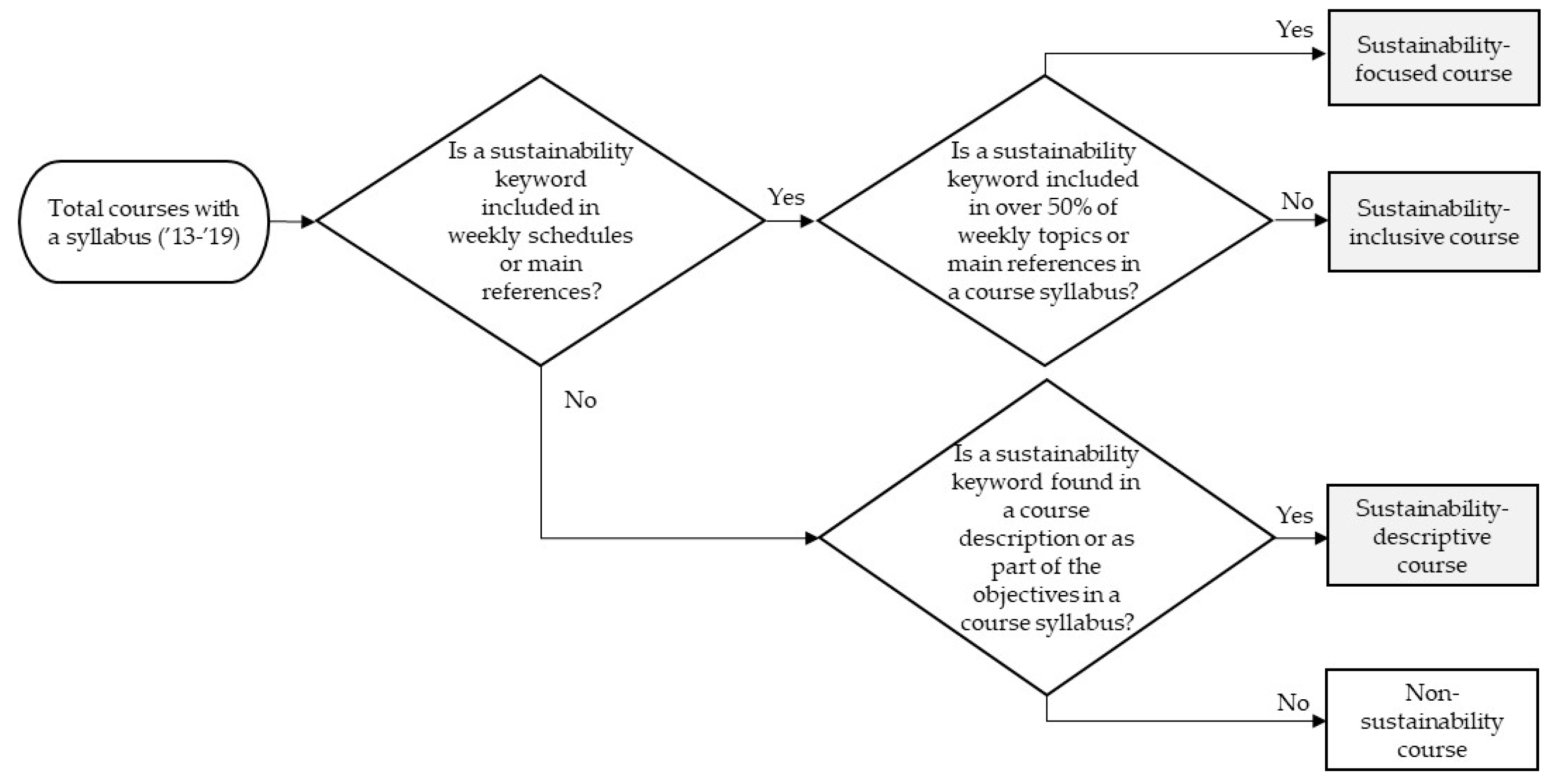
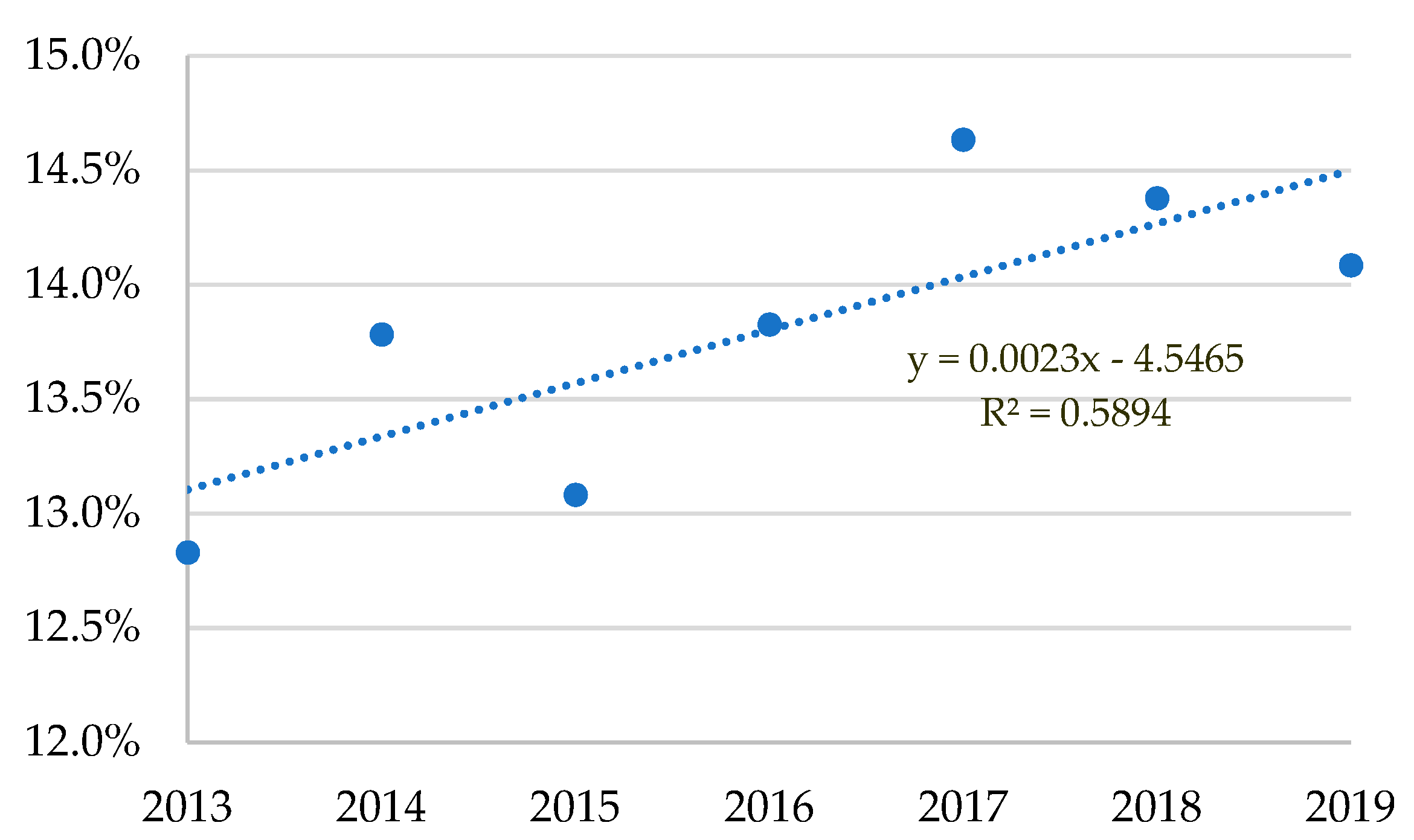
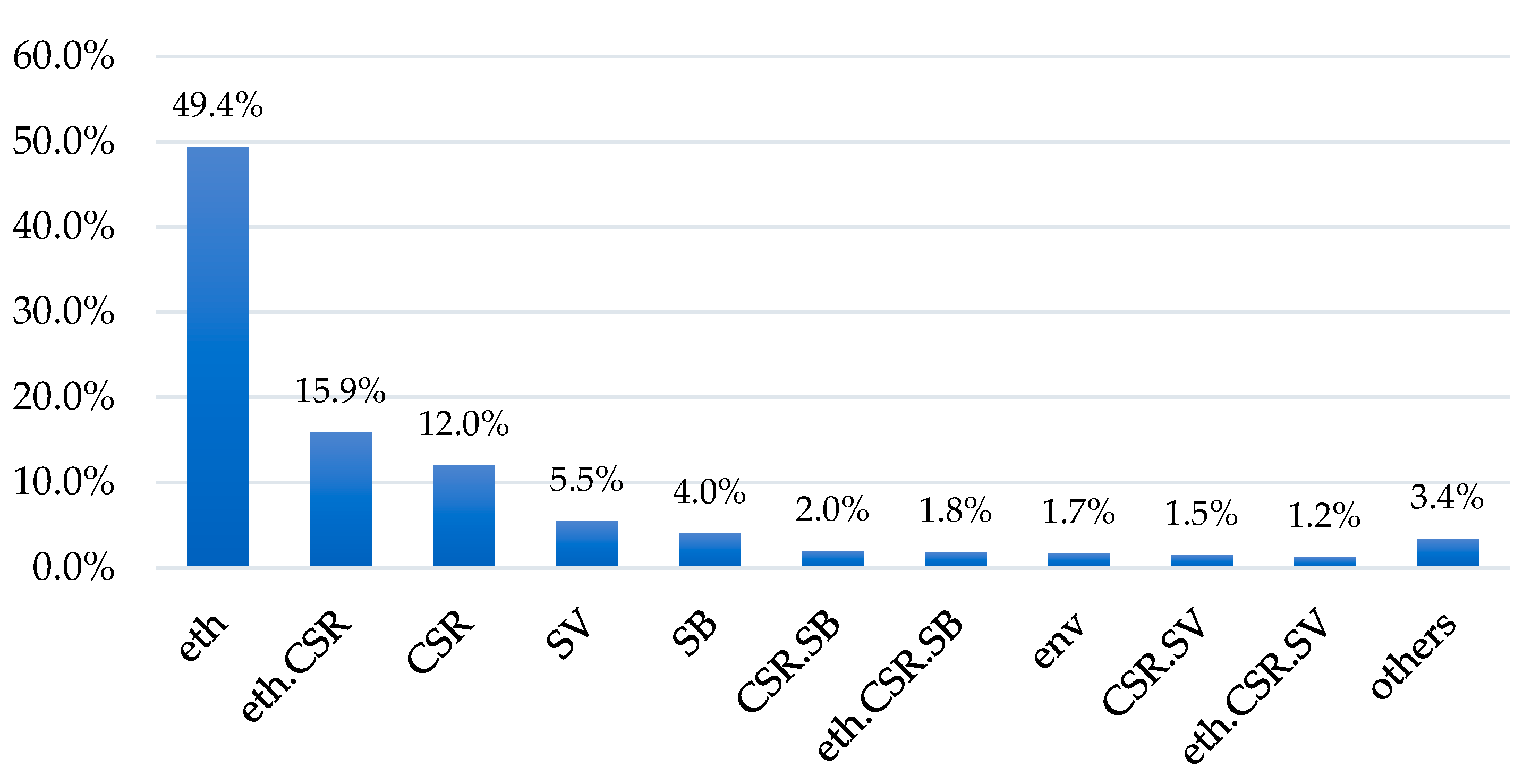
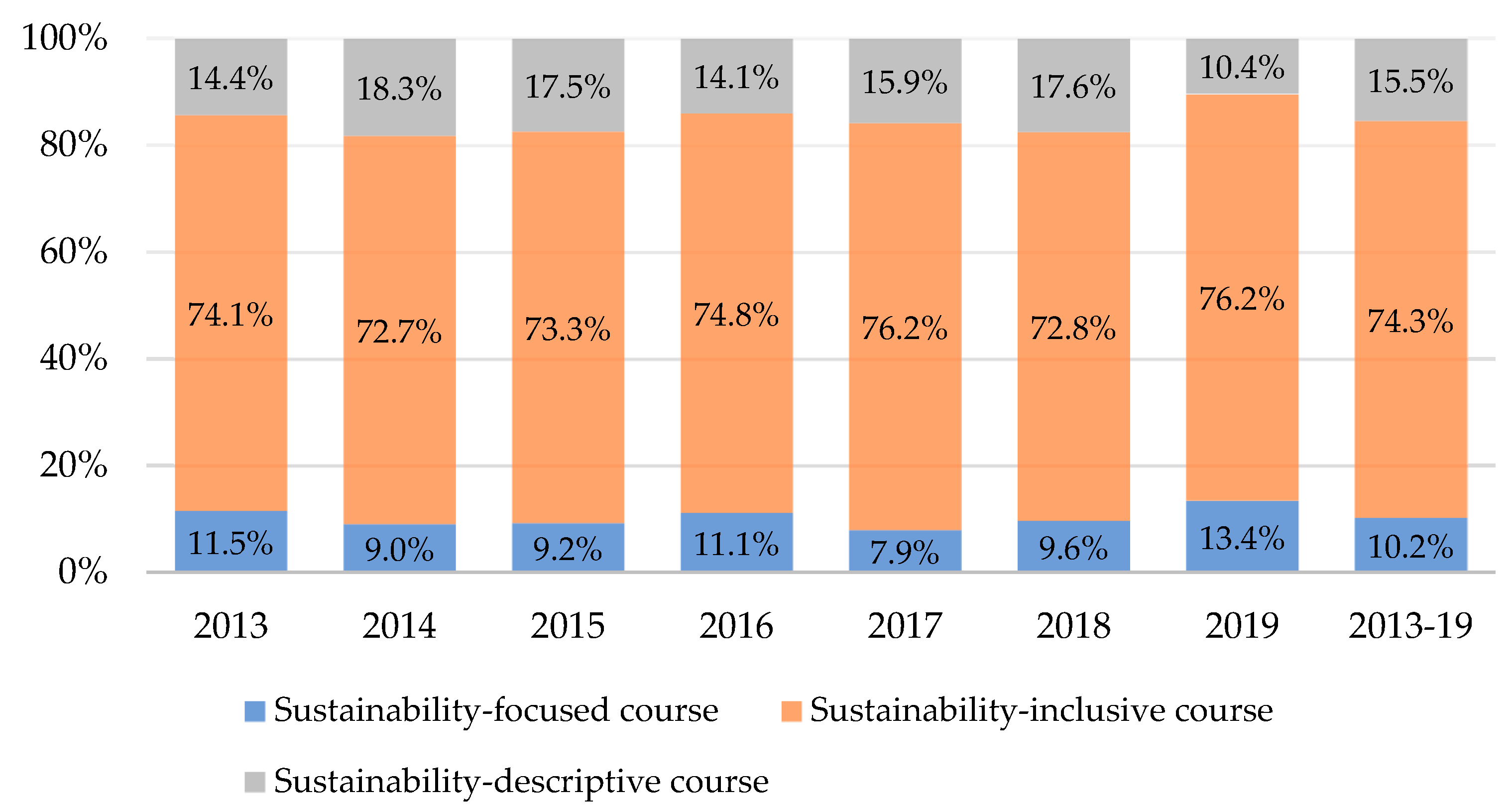
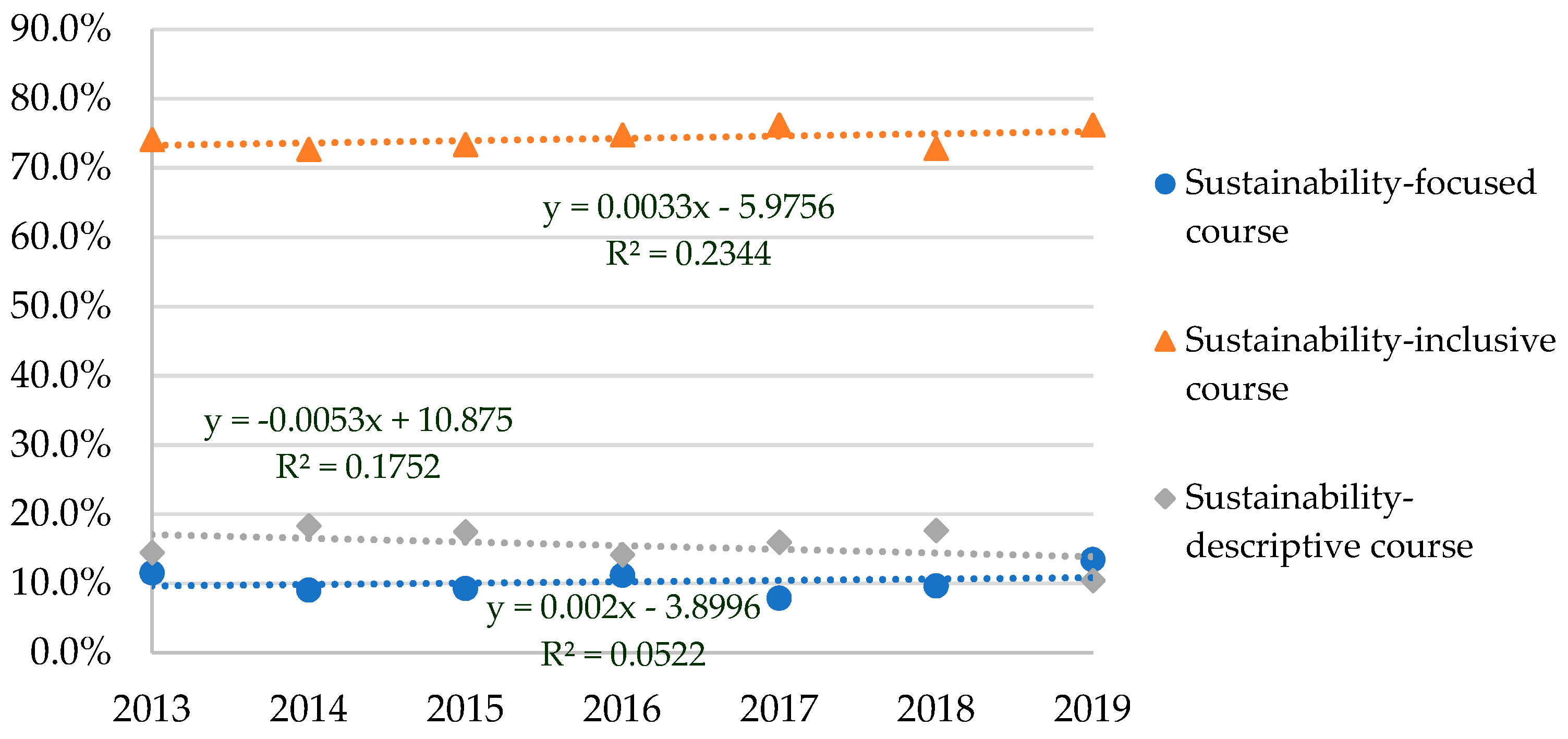
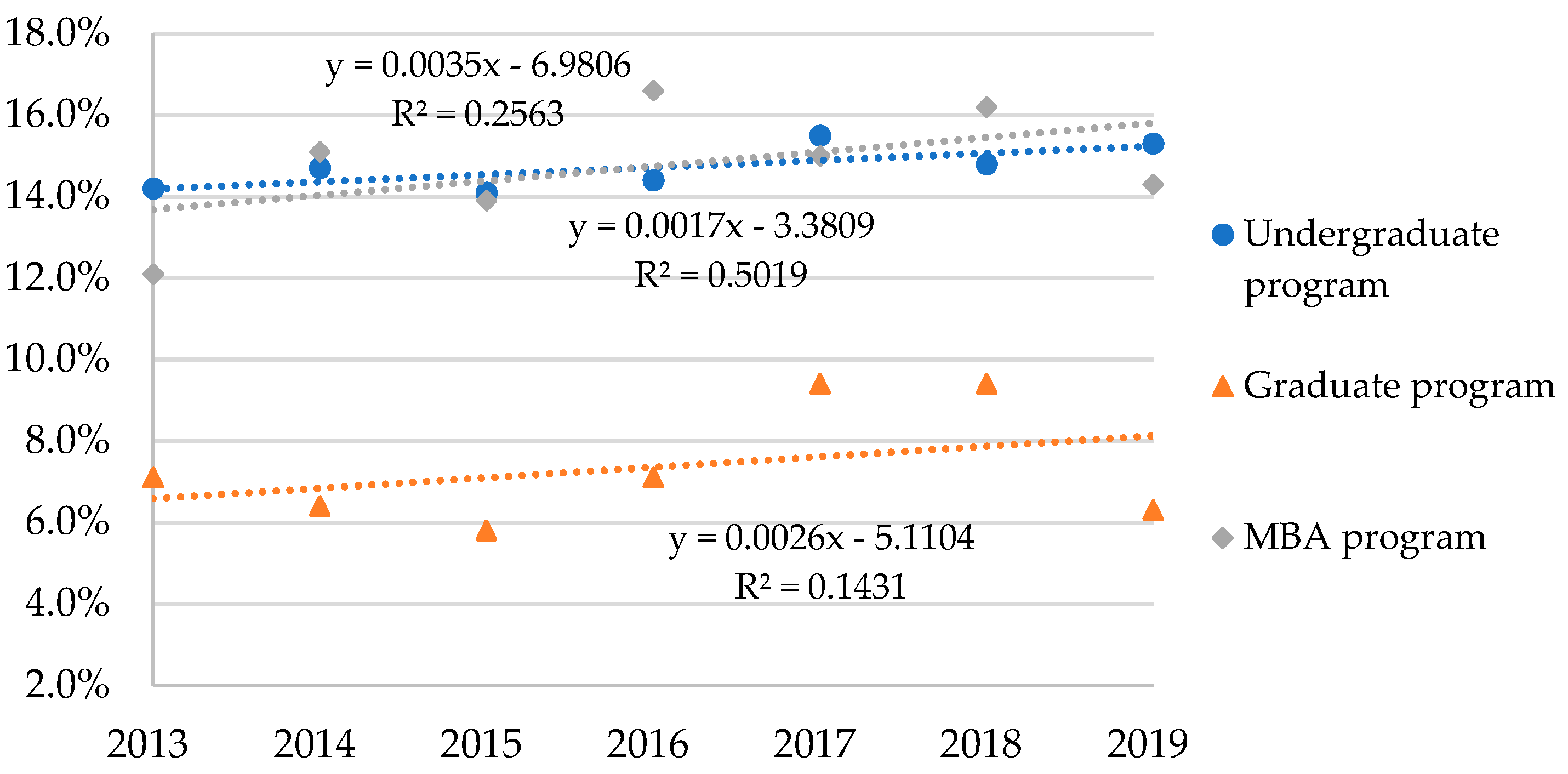
| Ethics “eth” | CSR “CSR” | Social Value “SV” | Environment “env” | Finance “fin” | Sustainable Business “SB” |
|---|---|---|---|---|---|
| Ethics | Business and society | Social value | Env. management | ESG | Sustainability |
| Business ethics | CSR | Social enterprise | Green management | Social finance | Sustainable business |
| Ethical management | Sustainable supply chain | Social entrepreneurship | Environmental (env.) sustainability | Socially responsible investing (SRI) | Sustainable management |
| Management ethics | CSV/shared value | Social venture | Climate change | Impact investing | |
| Philanthropy | Social economy | Eco-friendly | |||
| Social responsibility | Sharing economy | Env. value | |||
| Dev. Cooperation |
| Year | Total Number of Courses with a Syllabus (A) | Number of Sustainability Courses (B) | Proportion of Sustainability to Total Courses (B/A) 1 | Rate of Change 3 (△B/△A) 2 |
|---|---|---|---|---|
| 2013 | 2905 | 374 | 12.9% | N/A |
| 2014 | 2885 | 399 | 13.8% | 9.7 |
| 2015 | 2970 | 390 | 13.1% | 0.8 |
| 2016 | 2882 | 404 | 14.0% | 1.2 |
| 2017 | 2903 | 433 | 14.9% | 9.9 |
| 2018 | 3018 | 448 | 14.8% | 0.9 |
| 2019 | 2944 | 432 | 14.7% | 1.5 |
| Total (’13–’19) | 20,507 | 2880 | 14.0% | N/A |
| Degree Program | 2013 | 2014 | 2015 | 2016 | 2017 | 2018 | 2019 | All Years Combined | |
|---|---|---|---|---|---|---|---|---|---|
| Under-graduate | Sustainability courses (%) | 285 (14.2%) | 303 (14.7%) | 305 (14.1%) | 299 (14.4%) | 326 (15.5%) | 334 (14.8%) | 343 (15.3%) | 2195 (14.7%) |
| Total courses | 2009 | 2062 | 2160 | 2081 | 2108 | 2254 | 2242 | 14,916 | |
| Graduate | Sustainability courses (%) | 29 (7.1%) | 22 (6.4%) | 21 (5.8%) | 26 (7.1%) | 34 (9.4%) | 35 (9.4%) | 23 (6.3%) | 190 (7.4%) |
| Total courses | 409 | 342 | 362 | 365 | 363 | 374 | 363 | 2578 | |
| MBA | Sustainability courses (%) | 60 (12.1%) | 74 (15.1%) | 64 (13.9%) | 79 (16.6%) | 73 (15.0%) | 79 (16.2%) | 66 (14.3%) | 495 (14.7%) |
| Total courses | 497 | 491 | 459 | 476 | 488 | 488 | 462 | 3361 | |
| Degree Program | Course Classification | 2013 | 2014 | 2015 | 2016 | 2017 | 2018 | 2019 | All Years Combined |
|---|---|---|---|---|---|---|---|---|---|
| Under-graduate | Focused | 23 (8.1%) | 22 (7.3%) | 23 (7.5%) | 29 (9.7%) | 23 (7.1%) | 27 (8.1%) | 43 (12.5%) | 190 (8.6%) |
| Inclusive | 219 (76.8%) | 234 (77.2%) | 234 (76.7%) | 230 (76.9%) | 253 (77.6%) | 252 (75.4%) | 272 (79.3%) | 1694 (77.2%) | |
| Descriptive | 43 (15.1%) | 47 (15.5%) | 48 (15.7%) | 40 (13.4%) | 50 (15.3%) | 55 (16.5%) | 28 (8.2%) | 311 (14.2%) | |
| Total | 285 | 303 | 305 | 299 | 326 | 334 | 343 | 2195 | |
| Graduate | Focused | 8 (27.6%) | 2 (9.1%) | 2 (9.5%) | 7 (26.9%) | 4 (11.8%) | 5 (14.3%) | 1 (4.3%) | 29 (14.8%) |
| Inclusive | 20 (69.0%) | 17 (77.3%) | 19 (90.5%) | 18 (69.2%) | 27 (79.4%) | 24 (68.6%) | 19 (82.6%) | 144 (76.6%) | |
| Descriptive | 1 (3.4%) | 3 (13.6%) | 0 (0.0%) | 1 (3.8%) | 3 (8.8%) | 6 (17.1%) | 3 (13.0%) | 17 (8.6%) | |
| Total | 29 | 22 | 21 | 26 | 34 | 35 | 23 | 190 | |
| MBA | Focused | 12 (20.0%) | 12 (16.2%) | 11 (17.2%) | 9 (11.4%) | 7 (9.6%) | 11 (13.9%) | 14 (21.2%) | 76 (15.6%) |
| Inclusive | 38 (63.3%) | 39 (52.7%) | 33 (51.6%) | 54 (68.4%) | 50 (68.5%) | 50 (63.3%) | 38 (57.6%) | 302 (60.8%) | |
| Descriptive | 10 (16.7%) | 23 (31.1%) | 20 (31.3%) | 16 (20.3%) | 16 (21.9%) | 18 (22.8%) | 14 (21.2%) | 117 (23.6%) | |
| Total | 60 | 74 | 64 | 79 | 73 | 79 | 66 | 495 |
Publisher’s Note: MDPI stays neutral with regard to jurisdictional claims in published maps and institutional affiliations. |
© 2021 by the authors. Licensee MDPI, Basel, Switzerland. This article is an open access article distributed under the terms and conditions of the Creative Commons Attribution (CC BY) license (http://creativecommons.org/licenses/by/4.0/).
Share and Cite
Jun, H.; Moon, S. An Analysis of Sustainability Integration in Business School Curricula: Evidence from Korea. Sustainability 2021, 13, 2779. https://doi.org/10.3390/su13052779
Jun H, Moon S. An Analysis of Sustainability Integration in Business School Curricula: Evidence from Korea. Sustainability. 2021; 13(5):2779. https://doi.org/10.3390/su13052779
Chicago/Turabian StyleJun, Hannah, and Seoyoung Moon. 2021. "An Analysis of Sustainability Integration in Business School Curricula: Evidence from Korea" Sustainability 13, no. 5: 2779. https://doi.org/10.3390/su13052779
APA StyleJun, H., & Moon, S. (2021). An Analysis of Sustainability Integration in Business School Curricula: Evidence from Korea. Sustainability, 13(5), 2779. https://doi.org/10.3390/su13052779







